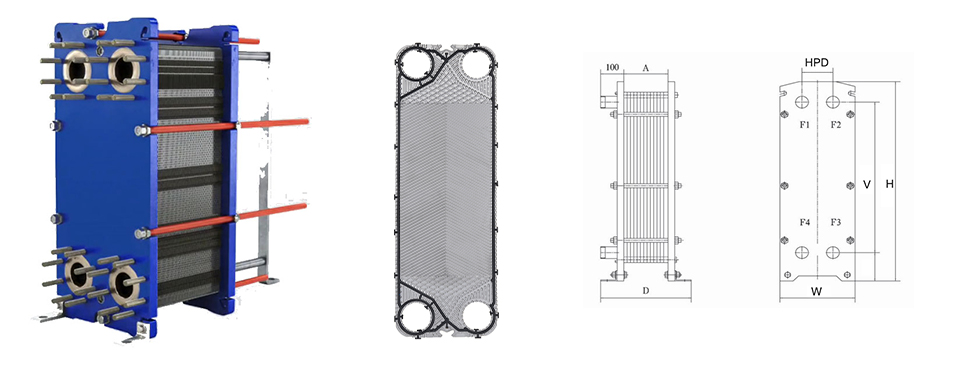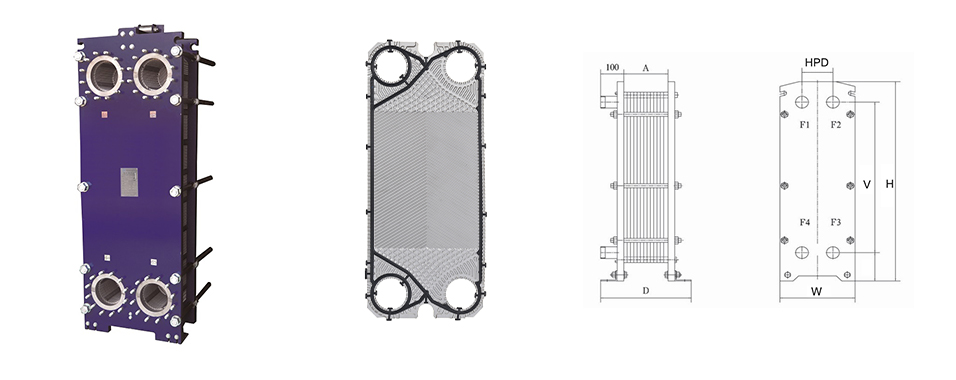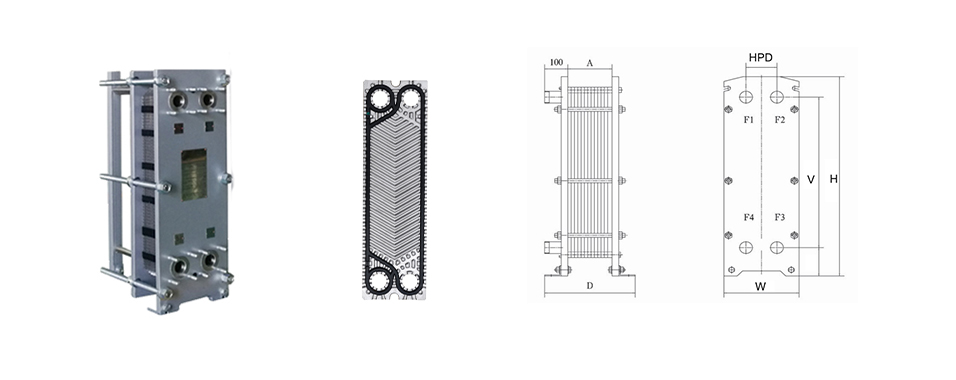Machinery--Manufacturing plate heat exchangers
Machinery
The heat exchanger applied in the process:
Crude heat exchanger before desalination: crude oil of about 20-45 ℃ flows into the heat exchanger and then into the electrical desalter after being heated up to 110-120 ℃.
Crude heat exchanger after desalination: desalted crude oil flows into the primary tower after being heated up to 220-240℃.
Primary distilled oil heat exchanger: After primary distillation the oil flows into the heat exchanger and is heated to 270-280 ℃.
Primary overhead oil heat exchanger: the overhead oil gas is cooled down to 40℃ after passing through the overhead hot-water heat exchanger and air cooler and flows into the overhead reflux tank.
Overhead oil gas heat exchanger: the oil gas from the atmospheric overhead enters into the return tank (Volumn-103) for oil-water separation after being cooled to 70 ℃ by the air cooler.
Overhead oil-water cooler: Non-condensable oil gas is cooled down to 40 ℃ by the condenser after entering the overhead product tank for oil-water separation.
First-line oil heat exchanger: the primary distilled oil which is heated up to 370-380 ℃ by the atmosphere furnace flows into the first-line oil heat exchanger and is cooled down to 45℃.
Second-line oil heat exchanger: the primary distilled oil which is heated up to 370-380 ℃ by the atmosphere furnace flows into the second-line oil heat exchanger and is cooled down to 60-70℃.
Third-line oil heat exchanger: the primary distilled oil which is heated up to 370-380 ℃ by the atmosphere furnace flows into the third-line oil heat exchanger and is cooled down to 70℃.
Atmospheric residual oil heat exchanger:
First vacuum side stream heat exchanger: first vacuum side stream is exhausted from the first layer of oil sump tank and cooled down to 80℃ after heat exchange, some of which flows out as product and some of which returns to the upper part of the first padding section as vacuum overhead reflux oil after being cooled down to 40℃ by the condenser.
Second vacuum side stream heat exchanger: second vacuum side stream is exhausted from the second layer of oil sump tank, one line of which is cooled down to 80℃ after heat exchange and flows out as product, one of which returns to the upper part of the second padding section as vacuum overhead reflux oil and the other of which returns to the upper part of the third padding section as light wash oil with no need to be cooled.
Third vacuum side stream heat exchanger: third vacuum side stream mixes with the second vacuum side stream, enters into the mixed heavy oil line which is cooled down to 80℃ after heat exchange and flows out as product
The vacuum residual oil heat exchanger: the vacuum residual oil is extracted from the bottom of the vacuum tower by the pump after it is cooled to 120 ℃, one of which flows out, one of which mixes with the second and third vacuum side stream into the mixed heavy oil line and flows out.
Tag:Plate Heat Exchangers
The heat exchanger applied in the process:
Crude heat exchanger before desalination: crude oil of about 20-45 ℃ flows into the heat exchanger and then into the electrical desalter after being heated up to 110-120 ℃.
Crude heat exchanger after desalination: desalted crude oil flows into the primary tower after being heated up to 220-240℃.
Primary distilled oil heat exchanger: After primary distillation the oil flows into the heat exchanger and is heated to 270-280 ℃.
Primary overhead oil heat exchanger: the overhead oil gas is cooled down to 40℃ after passing through the overhead hot-water heat exchanger and air cooler and flows into the overhead reflux tank.
Overhead oil gas heat exchanger: the oil gas from the atmospheric overhead enters into the return tank (Volumn-103) for oil-water separation after being cooled to 70 ℃ by the air cooler.
Overhead oil-water cooler: Non-condensable oil gas is cooled down to 40 ℃ by the condenser after entering the overhead product tank for oil-water separation.
First-line oil heat exchanger: the primary distilled oil which is heated up to 370-380 ℃ by the atmosphere furnace flows into the first-line oil heat exchanger and is cooled down to 45℃.
Second-line oil heat exchanger: the primary distilled oil which is heated up to 370-380 ℃ by the atmosphere furnace flows into the second-line oil heat exchanger and is cooled down to 60-70℃.
Third-line oil heat exchanger: the primary distilled oil which is heated up to 370-380 ℃ by the atmosphere furnace flows into the third-line oil heat exchanger and is cooled down to 70℃.
Atmospheric residual oil heat exchanger:
First vacuum side stream heat exchanger: first vacuum side stream is exhausted from the first layer of oil sump tank and cooled down to 80℃ after heat exchange, some of which flows out as product and some of which returns to the upper part of the first padding section as vacuum overhead reflux oil after being cooled down to 40℃ by the condenser.
Second vacuum side stream heat exchanger: second vacuum side stream is exhausted from the second layer of oil sump tank, one line of which is cooled down to 80℃ after heat exchange and flows out as product, one of which returns to the upper part of the second padding section as vacuum overhead reflux oil and the other of which returns to the upper part of the third padding section as light wash oil with no need to be cooled.
Third vacuum side stream heat exchanger: third vacuum side stream mixes with the second vacuum side stream, enters into the mixed heavy oil line which is cooled down to 80℃ after heat exchange and flows out as product
The vacuum residual oil heat exchanger: the vacuum residual oil is extracted from the bottom of the vacuum tower by the pump after it is cooled to 120 ℃, one of which flows out, one of which mixes with the second and third vacuum side stream into the mixed heavy oil line and flows out.
Tag:Plate Heat Exchangers








